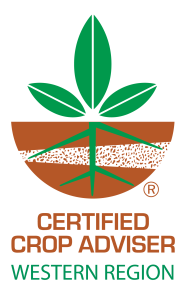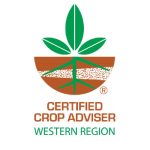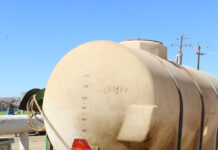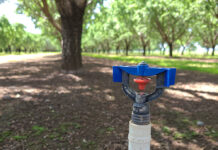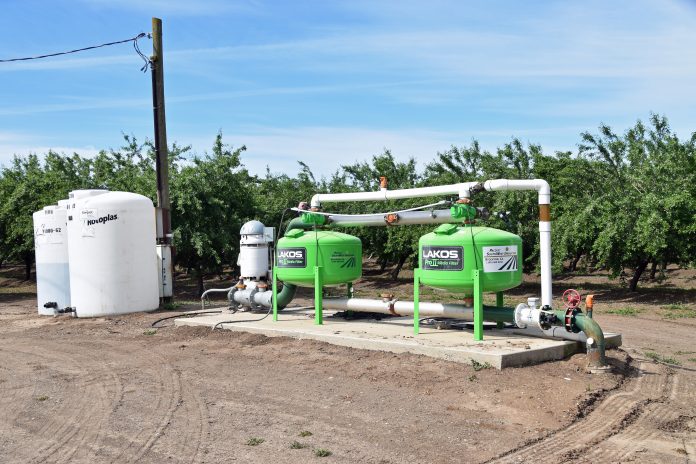
Water ties all aspects of crop production together and is the largest input on most farm operations on a per-acre basis (both by volume and weight.) Aside from recent challenges with water quantity, we are also experiencing issues with quality, or the chemical and physical properties that characterize a water source. In this article, I will describe how water quality is important to five categories of farm management: nitrogen management plans, fertilizer performance, predicting salinity issues, irrigation efficiency and distribution uniformity, and interactions with crop protection products (Figure 1).
Given the long list of interactions that farm water quality can impact, I would like to make the case for the explicit consideration of what I call “the agronomy of water”, in which we are managing this input similarly to how we take soil and plant tissue tests. After reading this, my hope is to convince you of the utility derived from water sample data to help manage this important natural resource. Remember, a water sample can help inform the management strategy of the five aforementioned categories, often in the same analysis. Thus, a water sample can allow you to better manage five aspects of crop production for the price of one analysis.
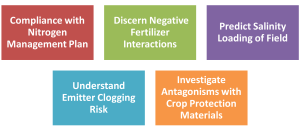
Nitrogen Management Plans
All water sources contain dissolved ions in various quantities. Most often, we think of the ions that cause salinity issues and toxicities, which include sodium and chloride. However, due to recent changes in regulatory policy, we now must think about the nutrient content of water applied to field to help mitigate groundwater pollution risk. In this case, nitrate (NO3–) values can be measured in your irrigation water, converted to lbs/acre, and applied against your annual crop nitrogen budget. The benefit of a water quality analysis is that you can keep track of other important nutrients, which can help inform your overall management program. A water sample can help estimate the presence of nitrates in your irrigation water and contribute to an improved understanding regarding in-field nitrogen management compliance.
Predictive Salinity Management
Soil salinity is often caused by the application of irrigation water that is high in dissolved salts, particularly sodium, chlorine and boron. These ions can cause a loss in crop yield due to specific ion toxicities (e.g., boron toxicity) and, in the case of sodium, can drive a loss of soil structure, impairing drainage and impeding water penetration and infiltration. A water sample can help quantify your risk of salt damage to your fields and crops and help you formulate a proactive reclamation plan.
Negative Fertilizer Interactions
Ok, so you have the water, now you just apply it to the crop, right? Not so fast! Ions in the water can interact with each other and form solid precipitates (chalky or cottage cheese like substances). For example, water that is high in calcium and/or has a high pH can negatively interact with the phosphate in your fertilizer program. When calcium and phosphate come together, they form a mineral called apatite that is highly insoluble. This can have a severe impact on the liquid blends you are applying to your crops. I have seen cases where one ranch has tremendous success running a certain blend but the ranch down the road cannot use the same formulation due to interactions with local water quality. Along the same lines, when phosphate and calcium form precipitates, the nutrients are no longer available for your crop to drive yield, which is a waste of input dollars. A water sample can help quantify your risk of negative fertilizer interactions, which can help you choose the right kinds of formulations based on your on-farm water quality.
Irrigation Efficiency and Distribution Uniformity
Continuing with the clogging theme, fertilizer precipitates, and other minerals, can also lodge themselves in drip emitters, sprinkler heads and other types of nozzles. Once these particles clog your system, you lose irrigation system efficiency. When your irrigation system is clogged, you now must use more water and power to deliver the same irrigation set to your thirsty crops than you would if your system had higher efficiency. Furthermore, the clogging of lines can impact some parts of the field more than others, causing an issue with the distribution uniformity of your applied water. A water sample can help you understand drip system clogging risk and formulate a plan to deal with it. Further fieldwork is required to quantify changes in distribution uniformity across a field, but it can be beneficial for improving overall irrigation efficiency.
Ag Chem Efficacy
Now let’s turn to your crop protection program. An essential question to ask here is, “How good is your spray water quality?” The answer demonstrates the connection between your ag chem programs (e.g., pesticides, herbicides and fungicides) and the most common mechanism for conveyance (e.g., spray water). However, the constituents of the water can have severe impacts on the pest control capacity of your ag chem spray program (e.g., efficacy). A pesticide spray that controls a pest to a high degree per application has high efficacy. An ag chem spray that doesn’t quite do the job has low efficacy. Efficacy is strongly influenced by the interaction between the active ingredient in your applied pesticide and the water it is mixed with (e.g., spray tank, chemigation, etc.)
Five main physical components of water can have a negative influence on efficacy: pH, bicarbonates, hardness, total dissolved solids and turbidity. For example, spray water that is characterized by alkaline pH (>7) can cause an issue called alkaline hydrolysis, a scenario where the pH causes the active ingredient in the crop protection product to lose its efficacy due to physical and chemical deterioration. In another example, certain ions in the spray water, called hardness, can tie up the active ingredient in your ag chem and render it unusable for pest control.
Some pesticides are more strongly influenced by these components than others, and management programs should work to improve efficacy on a case-by-case basis. A water sample can help you determine how your ag chem sprays interact with water quality and put together a water conditioning and adjuvant plan to improve the overall activity and control of your pesticide programs.
Take a Water Sample
The importance of understanding your water quality cannot be understated, and a water sampling program will help you form a solid foundation of “water” agronomy and will produce tangible benefits for your farm. Ironically, while water is often the largest farm input by volume and weight, a water sample can be one of the cheapest inputs (e.g., $/acre) around as one water source can serve many acres on a given ranch. However, many folks do not have a regular water sampling program in place to monitor changes in water quality. Talk to a Certified Crop Advisor today about starting a water sampling program and to improve the agronomy of water on your farm operation across the five categories described above.
Resources
Irrigation Water Salinity and Crop Production, anrcatalog.ucanr.edu/pdf/8066.pdf
The Impact of Water Quality on Pesticide Performance, extension.purdue.edu/extmedia/ppp/ppp-86.pdf
Water Quality for Crop Production, ag.umass.edu/sites/ag.umass.edu/files/book/pdf/ghbmpwaterqualityforcropprod.pdf
Agronomy of Water FieldLink (originally created by author), helenaagri.com/fieldlink/the-agronomy-of-water/
The Agronomy of Water Series (2 CCA credits available: Soil and Water), wrcca.org/continuinged
Five Tools For The Price Of One: The Case For Farm Water Testing https://nutrien-ekonomics.com/news/five-tools-for-the-price-of-one-the-case-for-farm-water-testing/
